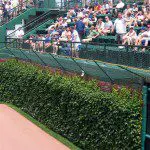Ivy on Brick – Is it a Concern?

You should be concerned about ivy on brick if cracks appear, the mortar is crumbling, or brick is loose. Ivy leafs won’t cause damage but the roots growing in these vulnerable areas of the wall can expand cracks allowing water to penetrate the surface. I know one incident where the ivy opened a caulked crack in a foundation and water seeped in. Homes built before 1930 may be susceptible to damage because of the softer lime-based mortar used then. Mortar replacement or what’s called repointing, may be required.
Tuckpointing ivy covered brick requires removing or carefully pulling the ivy loose to apply a coating of cement-based mortar over existing joints. The ivy can then be repositioned or replanted. The ivy at Wrigley Field is Boston Ivy and Japanese Bittersweet. Bill Veeck planted it in 1937 during an outfield beautification project.
For your own beautification project keep the brick and mortar in good shape. The ivy won’t infiltrate a well-built, solid brick wall. If you have questions about tuckpointing your ivy covered brick walls in the Chicago metro area give me a call.


